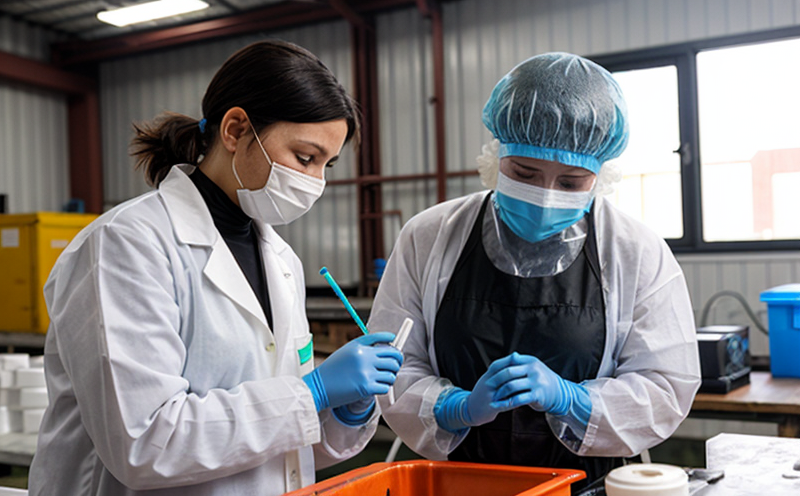ISO 29761 Surface Area Analysis of Recycled Carbon Nanomaterials
The analysis of recycled carbon nanomaterials (RCNMs) is essential in ensuring that these materials meet the necessary quality and performance standards. ISO 29761 provides a standardized approach to surface area determination, which is critical for understanding the properties and potential applications of RCNMs.
Surface area plays a crucial role in the functionality of carbon nanomaterials due to its influence on reactivity, dispersion stability, and chemical behavior. In recycled carbon nanomaterials, the presence of impurities from the original waste stream can significantly impact the surface chemistry and thus the surface area. Accurate measurement is necessary to ensure that RCNMs perform as expected in various applications.
The ISO 29761 standard specifies a method for determining the specific surface area of carbon nanomaterials using the Brunauer–Emmett–Teller (BET) technique. This technique involves adsorption of a gas onto the sample's surface at low pressures, and the resulting isotherm provides information about the pore size distribution and specific surface area.
The standard requires that the RCNMs be prepared in accordance with the specified procedure to ensure consistency and reliability of results. This includes precise drying techniques, milling if necessary, and sieving to obtain a consistent particle size range suitable for analysis.
Once prepared, the samples are subjected to BET analysis using a high-resolution gas adsorption instrument. These instruments provide detailed information about both the total surface area and the pore size distribution of the RCNMs. The results from these analyses can then be used to assess the quality of the material and its suitability for specific applications.
Understanding the surface area and pore structure is vital in industries such as electronics, automotive, and construction, where RCNMs are increasingly being used due to their unique properties. For instance, in electronics, higher surface area can enhance conductivity, while in construction, it can improve bonding strength.
The ISO 29761 standard ensures that the analysis of recycled carbon nanomaterials is conducted under controlled conditions, leading to consistent and accurate results. This is particularly important when comparing samples from different batches or suppliers. The standard also helps in identifying any issues with the material's quality, such as contamination or changes in structure due to recycling processes.
By adhering to ISO 29761, laboratories can provide reliable data that contributes to the development and improvement of products using recycled carbon nanomaterials. This not only enhances product performance but also supports sustainable practices by reusing waste materials effectively.
The standard's focus on precision and reproducibility ensures that the results are trustworthy across different testing facilities. This is especially important in regulatory environments where compliance with international standards is required to ensure safety and effectiveness of products.
Scope and Methodology
| Step | Action | Details |
|---|---|---|
| Sample Preparation | Dry the RCNMs at 105°C for 4 hours. | This ensures that any moisture content is removed, preventing errors in the BET analysis. |
| Milling (if necessary) | Mill the samples to a particle size of less than 30 μm. | The optimal particle size depends on the specific application and test requirements. |
| Sieving | Sieve the material through an appropriate mesh size, typically 200 mesh. | This ensures that only particles within a defined size range are used for analysis. |
| Adsorption Analysis | Perform BET analysis using a high-resolution gas adsorption instrument. | The equipment should be calibrated according to the manufacturer's instructions and operated under controlled conditions. |
| Data Interpretation | Analyze the isotherm data to determine total surface area and pore size distribution. | Interpretation involves using specialized software provided by the instrument manufacturer. |
Industry Applications
The analysis of recycled carbon nanomaterials (RCNMs) under ISO 29761 is particularly relevant in industries that require precise control over material properties. These include:
- Electronics: RCNMs are used to enhance conductivity and improve the performance of electronic components.
- Automotive: They contribute to lighter, stronger materials for vehicle parts, reducing weight and improving fuel efficiency.
- Construction: RCNMs can be incorporated into concrete mixtures to increase strength and durability.
- Consumer Products: Their use in consumer goods like paints, coatings, and adhesives improves their performance and longevity.
In each of these industries, the precise measurement of surface area is crucial for optimizing product design and ensuring compliance with regulatory standards. ISO 29761 ensures that the analysis of RCNMs is conducted in a consistent manner, providing reliable data that can be trusted across different testing facilities.
Eurolab Advantages
At Eurolab, we provide comprehensive and accurate surface area analysis for recycled carbon nanomaterials using ISO 29761. Our services are designed to meet the needs of quality managers, compliance officers, R&D engineers, and procurement professionals in various industries.
- Precision: Our laboratories use state-of-the-art equipment that ensures precise and reproducible results.
- Experienced Staff: Our team of experts has extensive experience in nanomaterials testing and can provide valuable insights into your specific needs.
- Compliance: We ensure that all tests are conducted according to the latest international standards, including ISO 29761.
- Fast Turnaround: Our efficient processes allow for quick turnaround times without compromising on quality.
- Detailed Reporting
We provide detailed reports that include not only the specific surface area but also information about the pore size distribution, which is crucial for understanding the material's properties and potential applications. This comprehensive approach ensures that our clients have all the necessary data to make informed decisions.
Our commitment to quality and reliability is reflected in the consistent accuracy of our results. We understand the importance of these tests in ensuring product performance and compliance with regulations, which is why we provide services that are tailored to meet your specific requirements.





